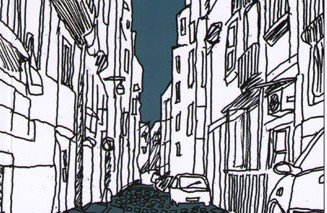Sacred, Profane Naples: In her collection of short stories, Italian novelist Valeria Parrella catches the intrinsically Baroque side of Naples and its inhabitants
With its colourful carnival of clothes and bed sheets hanging from the windows, its maze of narrow streets and secret corners, its roaring chaos of motorbikes and shouting vendors, its inebriating mixture of coffee aromas and pizza flavours, Naples is by its nature a Baroque city.
If the dramatic style of Baroque architecture and art was meant to impress visitors through a triumphant abundance of details and display of opulence, no city better than Naples expresses such a baroque-like attitude to life, being able to enchant and bewilder whoever happens to be overwhelmed by the ordered anarchy of the city.
Home to Caravaggio while he was outlawed, and an inspiration to his Madonna of the Rosary and The Seven Acts of Mercy (1607), Naples has continued to inspire a whole generation of internationally renowned artists up till today, from the actor and film director Massimo Troisi to the writer and journalist Roberto Saviano, who have been able to capture the double-sided nature of the city, with its inseparable blend of sacred and profane, richness and misery, tragedy and laughter.
A recent discovery for the American book industry, Valeria Parrella belongs to this new generation of artists, being one of the most talented novelists in Italy, as well as a passionate storyteller of Naples’ marvels. Born in 1974 in Torre del Greco, in the Province of Naples, she published the volume of short stories Mosquito and Whale in 2003, and was awarded with the Campiello Literary Prize in 2004 for the best debut. She is also author of the novels The Verdict (2007) and The White Space (2008), which has recently become a film, directed by Francesca Comencini and screened at the last edition of the Venice Film Festival.
The New York based-publisher Europa Editions has recently decided to introduce Valeria Parrella to the English-language audience, by publishing the short story collection For Received Grace, originally published in Italy by Minimum fax in 2005 and awarded with important literary prizes.
The title comes from a common religious expression, which can be found on most “ex-votos” and other religious collectables under the initials “P.G.R.” (in Italian: Per grazia ricevuta), as a sign of gratitude or devotion. The sense of religiousness pervading Valeria Parrella’s book is however very atypical and profane, and allows the author to consecrate the humblest and most neglected humanity to the highest levels of purity and dignity.
There is the woman left with a child and a job in the drug trade after the death of her partner; the young man who gives up his passion for guitar to start working for an illegal print shop; the married museum curator dealing with the “imaginary friend” of her daughter and her equally imaginary alternative love life; the lonely woman renovating her house while dreaming of passionate happy-endings that don’t materialize. And on the background there is Naples, the city of the thousands faces and districts, where the areas devastated by a permanent state of urban guerrilla strife coexist alongside well-off residential neighborhoods.
If Caravaggio found the perfect features for his sacred portraits in the street-life scenes, Valeria Parrella finds the solitary heroes of the contemporary fight for survival in the forgotten slums and suburbs of Naples. The women depicted in this collage of stories are strong in their vulnerability and never ask for compassion or forgiveness: they look ahead, over their sense of abandon and despair, and always seem to know what to do, even if it means taking responsibility for their own or others’ faults. There is a beauty in this sort of failure that all the characters have in common: all of them have to give up something in order to go on in life, all of them have to fail in order to survive. Their decay coincides with their most triumphant magnificence, which is the paradoxical nature of the city itself. With its contradictions and conflicts, lights and shadows – said the author in an interview – Naples “shapes its inhabitants, carving and chiseling them in its likeness.”
To portray this urban circus of variegated humanity, Valeria Parrella uses a language that reproduces the faults and accents of the spoken words, with their dialectal inflections, their broken structure and peculiar drawled rhythm.
These stylistic features and the strong iconographic power of the language make the scenes and characters portrayed extraordinarily vivid and allow the readers to visualize every single situation, and hear every single voice, as in a film or in a real-life scene, where no boundaries are left between representation and reality.
Laura Giacalone is the Associate Editor of the Italian Journal.
